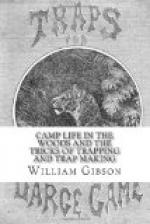Inhabiting the most lonely and inaccessible ranges of rock and mountain, the wild cat is seldom seen during the daytime. At night, like its domestic relative, he prowls far and wide, walking with the same stealthy step and hunting his game in the same tiger-like manner. He is by no means a difficult animal to trap, being easily deceived and taking a bait without any hesitation. The wild cat haunts the shores of lakes and rivers, and it is here that the traps may be set for them. Having caught and killed one of the colony, the rest of them can be easily taken if the body of the dead victim be left near their hunting ground and surrounded with the traps carefully set and concealed beneath leaves moss or the like. [Page 168] Every wild cat that is in the neighborhood will be certain to visit the body, and if the traps are rightly arranged many will be caught. The trap No. 3, page 141 is generally used. We would caution the young trapper in his approach to an entrapped wild cat, as the strength and ferocity of this animal under such circumstances, or when otherwise “hard pressed,” is perfectly amazing. When caught in a trap they spring with terrible fury at any one who approaches them, not waiting to be assailed, and when cornered or hemmed in by a hunter they will often turn upon their pursuer, and springing at his face will attack him with most consummate fury, often inflicting serious and sometimes fatal wounds. When hunted and attacked by dogs, the wild cat is a most desperate and untiring fighter, and extremely difficult to kill, for which reason it has been truthfully said that “if a tame cat has nine lives, a wild cat must have a dozen.”
The twitch-up, erected on a large scale, is utilized to a considerable extent in England in the capture of these animals; and these, together with steel traps and dead-falls, are about the only machines used for their capture. We would suggest the garrote, bow and gun trap also as being very effective. The bait may consist of the head of a fowl or a piece of rabbit or fowl flesh: or, indeed, flesh of almost any kind will answer, particularly of the bird kind.
In skinning the wild cat the same directions given under the head of the Fox may be followed, or the pelt may be ripped up the belly and spread on a hoop stretcher, page 275.
THE BEAR.
There are several species of the Bear tribe which inhabit our continent, the most prominent of which are the Grizzly, and the Musquaw or common Black Bear. There is no other animal of this country which is more widely and deservedly dreaded than the grizzly bear. There are other creatures, the puma and wild cat, for instance, which are dangerous when cornered or wounded, but they are not given to open and deliberate attack upon human beings. The grizzly, however, or “Ephraim,” as he is commonly termed by trappers, often displays a most unpleasant readiness




